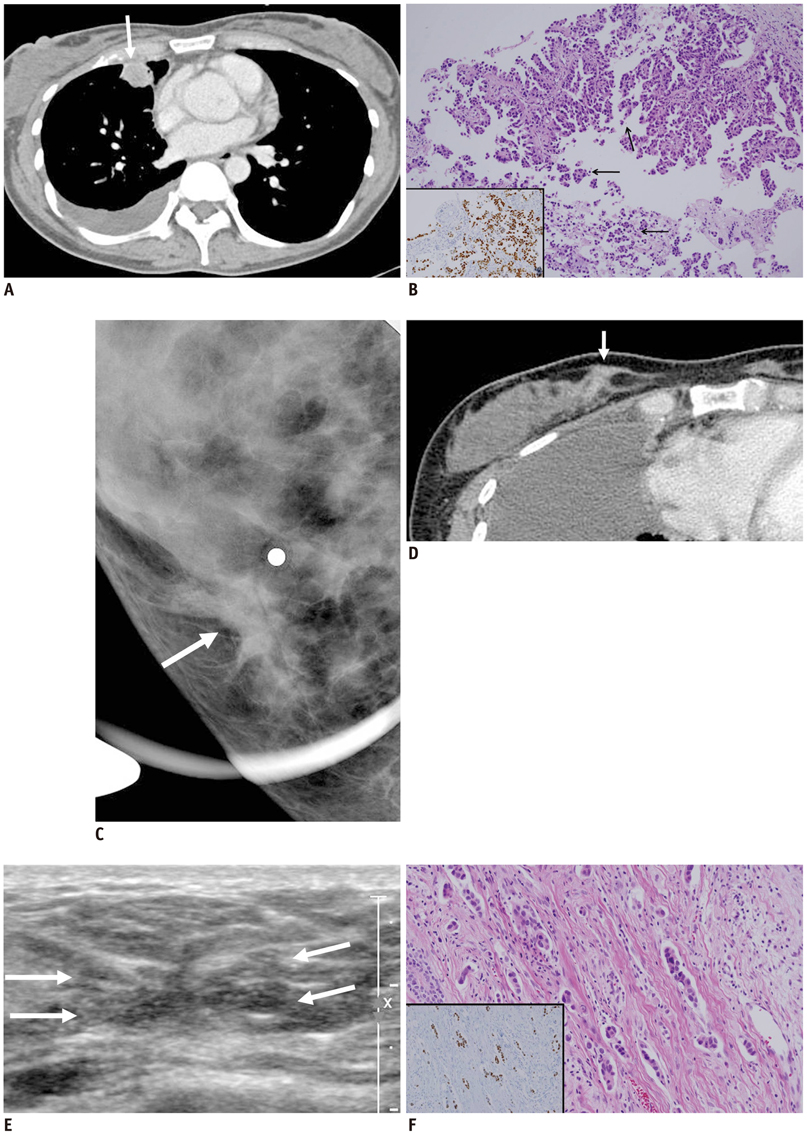Korean J Radiol.
2012 Apr;13(2):249-253. 10.3348/kjr.2012.13.2.249.
Micropapillary Lung Cancer with Breast Metastasis Simulating Primary Breast Cancer due to Architectural Distortion on Images
- Affiliations
-
- 1Department of Diagnostic Radiology, Center for Breast Cancer, National Cancer Center, Goyang 410-769, Korea.
- 2Department of Pathology, Center for Breast Cancer, National Cancer Center, Goyang 410-769, Korea. JaeRo@tmhs.org
- 3Department of Pathology, The Methodist Hospital, Weill Medical College of Cornell University, Houston, TX, USA.
- 4Department of Surgery, Center for Breast Cancer, National Cancer Center, Goyang 410-769, Korea.
- KMID: 1245392
- DOI: http://doi.org/10.3348/kjr.2012.13.2.249
Abstract
- A 47-year-old Korean woman with right middle lobe lung adenocarcinoma, malignant pleural effusion, and multiple lymph node and bone metastases, after three months of lung cancer diagnosis, presented with a palpable right breast mass. Images of the right breast demonstrated architectural distortion that strongly suggested primary breast cancer. Breast biopsy revealed metastatic lung cancer with a negative result for estrogen receptor (ER), progesterone receptor (PR) and mammaglobin, and a positive result for thyroid transcription factor-1 (TTF-1). We present a case of breast metastasis from a case of lung cancer with an extensive micropapillary component, which was initially misinterpreted as a primary breast cancer due to unusual image findings with architectural distortion.
MeSH Terms
-
Adenocarcinoma/drug therapy/*secondary
Antineoplastic Combined Chemotherapy Protocols/therapeutic use
Biopsy, Needle
Bone Neoplasms/secondary
Breast Neoplasms/drug therapy/*secondary
Diagnosis, Differential
Female
Humans
Lung Neoplasms/*pathology
Lymphatic Metastasis
Mammography
Middle Aged
Neoplasm Staging
Tomography, X-Ray Computed
Ultrasonography, Mammary
Figure
Reference
-
1. Lee SH, Park JM, Kook SH, Han BK, Moon WK. Metastatic tumors to the breast: mammographic and ultrasonographic findings. J Ultrasound Med. 2000. 19:257–262.2. Hajdu SI, Urban JA. Cancers metastatic to the breast. Cancer. 1972. 29:1691–1696.3. Vizcaíno I, Torregrosa A, Higueras V, Morote V, Cremades A, Torres V, et al. Metastasis to the breast from extramammary malignancies: a report of four cases and a review of literature. Eur Radiol. 2001. 11:1659–1665.4. Nassar H. Carcinomas with micropapillary morphology: clinical significance and current concepts. Adv Anat Pathol. 2004. 11:297–303.5. Amin MB, Tamboli P, Merchant SH, Ordóõez NG, Ro J, Ayala AG, et al. Micropapillary component in lung adenocarcinoma: a distinctive histologic feature with possible prognostic significance. Am J Surg Pathol. 2002. 26:358–364.6. Maeda R, Isowa N, Onuma H, Miura H, Harada T, Touge H, et al. Lung adenocarcinomas with micropapillary components. Gen Thorac Cardiovasc Surg. 2009. 57:534–539.7. Maounis N, Chorti M, Legaki S, Ellina E, Emmanouilidou A, Demonakou M, et al. Metastasis to the breast from an adenocarcinoma of the lung with extensive micropapillary component: a case report and review of the literature. Diagn Pathol. 2010. 5:82.8. Yang M, Nonaka D. A study of immunohistochemical differential expression in pulmonary and mammary carcinomas. Mod Pathol. 2010. 23:654–661.9. Gomez-Fernandez C, Mejias A, Walker G, Nadji M. Immunohistochemical expression of estrogen receptor in adenocarcinomas of the lung: the antibody factor. Appl Immunohistochem Mol Morphol. 2010. 18:137–141.10. Bhargava R, Beriwal S, Dabbs DJ. Mammaglobin vs GCDFP-15: an immunohistologic validation survey for sensitivity and specificity. Am J Clin Pathol. 2007. 127:103–113.11. Adrada B, Arribas E, Gilcrease M, Yang WT. Invasive micropapillary carcinoma of the breast: mammographic, sonographic, and MRI features. AJR Am J Roentgenol. 2009. 193:W58–W63.12. Paulus DD, Libshitz HI. Metastasis to the breast. Radiol Clin North Am. 1982. 20:561–568.13. Masmoudi A, Mathieu MC, Soria JC. Breast metastasis from lung adenocarcinoma: a case report. Anticancer Res. 2003. 23:1825–1826.
- Full Text Links
- Actions
-
Cited
- CITED
-
- Close
- Share
- Similar articles
-
- A case of stomach metastasis from breast cancer
- Metastatic Breast Cancer from Cervical Cancer
- Bladder Cancer Metastasis to the Breast in a Male Patient: Imaging Findings on Mammography and Ultrasonography
- Comment to “Patients with Concordant Triple-Negative Phenotype between Primary Breast Cancers and Corresponding Metastases Have Poor Prognosisâ€
- A Case of Small Cell Lung Cancer Metastastized to the Contralateral Breast


